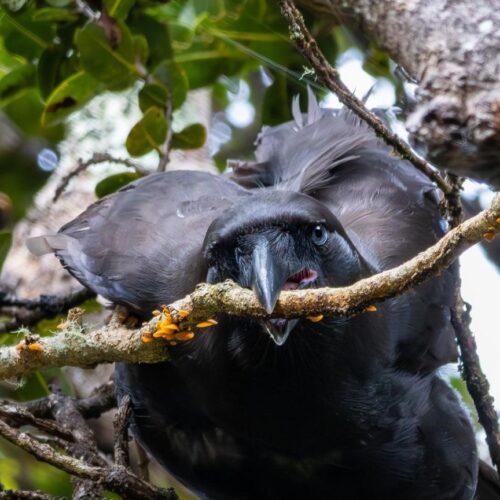Five alala are learning to live in the wild again

A monitoring team has witnessed nest-building activities within a cohort of five Hawaiian crows that were reintroduced into the wild on Maui. Department of Land and Natural Resources
Whether it produces chicks or not, state wildlife officials are encouraged to see nesting behaviors within a cohort of five alala, also known as Hawaiian crows, released on Maui late last year.
In addition to the birds’ successful nesting activities, the crows are showing other signs they’re adjusting to life in the wild such as expanded foraging for native fruits and insects.
According to the Hawaii Department of Land and Natural Resources, the five alala are the last remaining species of several native Hawaiian crows that once inhabited the islands. Alala have been extinct in the wild since 2002.
The five birds that were released on Maui were reared in captivity, but they have been flying free on the slopes of Haleakala since November.

Five Hawaiian crows, or alala, are showing more natural behaviors as they adjust to life in the wild following their release on Maui in November. Department of Land and Natural Resources
The Maui Forest Bird Recovery Project has been monitoring the alala while tracking their daily movements, documenting behavioral changes and providing supplemental food to support their transition into the wild.
During this monitoring, the alala have shown they are continuing to mature and adapt with an increasing range of natural behaviors including territorial vocalizations as well as their expanded foraging and pair-bonding activities.
“Seeing these birds forage on their own, interact naturally with one another and begin to exhibit courtship behaviors tells us that they’re adjusting to life in the wild,” said Hanna Mounce, program manager for the Maui Forest Bird Recovery Project. “They’re learning, adapting and behaving more and more like truly wild alala.”
In the past two months, the monitoring team has seen nest-building activities within the cohort of alala. More recently, the team saw a fully constructed nest and a female regularly sitting upon it.
The team says it is trying to keep its expectations cautious, but the pairing and nesting behavior is an encouraging step.
“This moment represents the culmination of decades of planning, perseverance and collaboration,” Mounce said. “Even if this nest doesn’t lead to chicks this year, it shows that the alala are reconnecting with their forest home. That gives us real hope for the future.”





